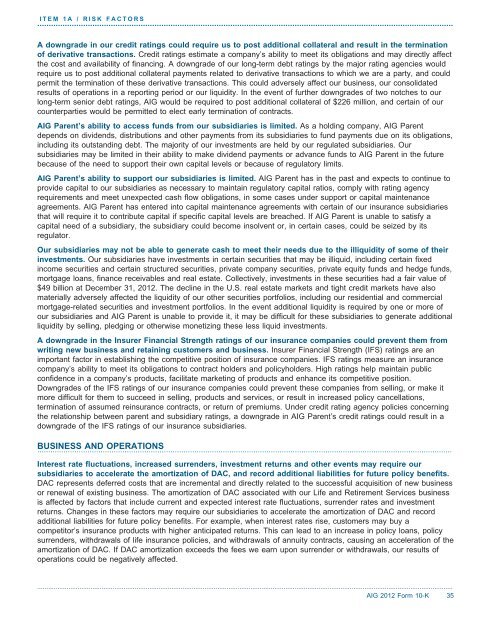Bring on tomorrow - AIG.com
Bring on tomorrow - AIG.com
Bring on tomorrow - AIG.com
Create successful ePaper yourself
Turn your PDF publications into a flip-book with our unique Google optimized e-Paper software.
ITEM 1A / RISK FACTORS.....................................................................................................................................................................................A downgrade in our credit ratings could require us to post additi<strong>on</strong>al collateral and result in the terminati<strong>on</strong>of derivative transacti<strong>on</strong>s. Credit ratings estimate a <strong>com</strong>pany’s ability to meet its obligati<strong>on</strong>s and may directly affectthe cost and availability of financing. A downgrade of our l<strong>on</strong>g-term debt ratings by the major rating agencies wouldrequire us to post additi<strong>on</strong>al collateral payments related to derivative transacti<strong>on</strong>s to which we are a party, and couldpermit the terminati<strong>on</strong> of these derivative transacti<strong>on</strong>s. This could adversely affect our business, our c<strong>on</strong>solidatedresults of operati<strong>on</strong>s in a reporting period or our liquidity. In the event of further downgrades of two notches to ourl<strong>on</strong>g-term senior debt ratings, <strong>AIG</strong> would be required to post additi<strong>on</strong>al collateral of $226 milli<strong>on</strong>, and certain of ourcounterparties would be permitted to elect early terminati<strong>on</strong> of c<strong>on</strong>tracts.<strong>AIG</strong> Parent’s ability to access funds from our subsidiaries is limited. As a holding <strong>com</strong>pany, <strong>AIG</strong> Parentdepends <strong>on</strong> dividends, distributi<strong>on</strong>s and other payments from its subsidiaries to fund payments due <strong>on</strong> its obligati<strong>on</strong>s,including its outstanding debt. The majority of our investments are held by our regulated subsidiaries. Oursubsidiaries may be limited in their ability to make dividend payments or advance funds to <strong>AIG</strong> Parent in the futurebecause of the need to support their own capital levels or because of regulatory limits.<strong>AIG</strong> Parent’s ability to support our subsidiaries is limited. <strong>AIG</strong> Parent has in the past and expects to c<strong>on</strong>tinue toprovide capital to our subsidiaries as necessary to maintain regulatory capital ratios, <strong>com</strong>ply with rating agencyrequirements and meet unexpected cash flow obligati<strong>on</strong>s, in some cases under support or capital maintenanceagreements. <strong>AIG</strong> Parent has entered into capital maintenance agreements with certain of our insurance subsidiariesthat will require it to c<strong>on</strong>tribute capital if specific capital levels are breached. If <strong>AIG</strong> Parent is unable to satisfy acapital need of a subsidiary, the subsidiary could be<strong>com</strong>e insolvent or, in certain cases, could be seized by itsregulator.Our subsidiaries may not be able to generate cash to meet their needs due to the illiquidity of some of theirinvestments. Our subsidiaries have investments in certain securities that may be illiquid, including certain fixedin<strong>com</strong>e securities and certain structured securities, private <strong>com</strong>pany securities, private equity funds and hedge funds,mortgage loans, finance receivables and real estate. Collectively, investments in these securities had a fair value of$49 billi<strong>on</strong> at December 31, 2012. The decline in the U.S. real estate markets and tight credit markets have alsomaterially adversely affected the liquidity of our other securities portfolios, including our residential and <strong>com</strong>mercialmortgage-related securities and investment portfolios. In the event additi<strong>on</strong>al liquidity is required by <strong>on</strong>e or more ofour subsidiaries and <strong>AIG</strong> Parent is unable to provide it, it may be difficult for these subsidiaries to generate additi<strong>on</strong>alliquidity by selling, pledging or otherwise m<strong>on</strong>etizing these less liquid investments.A downgrade in the Insurer Financial Strength ratings of our insurance <strong>com</strong>panies could prevent them fromwriting new business and retaining customers and business. Insurer Financial Strength (IFS) ratings are animportant factor in establishing the <strong>com</strong>petitive positi<strong>on</strong> of insurance <strong>com</strong>panies. IFS ratings measure an insurance<strong>com</strong>pany’s ability to meet its obligati<strong>on</strong>s to c<strong>on</strong>tract holders and policyholders. High ratings help maintain publicc<strong>on</strong>fidence in a <strong>com</strong>pany’s products, facilitate marketing of products and enhance its <strong>com</strong>petitive positi<strong>on</strong>.Downgrades of the IFS ratings of our insurance <strong>com</strong>panies could prevent these <strong>com</strong>panies from selling, or make itmore difficult for them to succeed in selling, products and services, or result in increased policy cancellati<strong>on</strong>s,terminati<strong>on</strong> of assumed reinsurance c<strong>on</strong>tracts, or return of premiums. Under credit rating agency policies c<strong>on</strong>cerningthe relati<strong>on</strong>ship between parent and subsidiary ratings, a downgrade in <strong>AIG</strong> Parent’s credit ratings could result in adowngrade of the IFS ratings of our insurance subsidiaries.BUSINESS AND OPERATIONS..............................................................................................................................................................................................Interest rate fluctuati<strong>on</strong>s, increased surrenders, investment returns and other events may require oursubsidiaries to accelerate the amortizati<strong>on</strong> of DAC, and record additi<strong>on</strong>al liabilities for future policy benefits.DAC represents deferred costs that are incremental and directly related to the successful acquisiti<strong>on</strong> of new businessor renewal of existing business. The amortizati<strong>on</strong> of DAC associated with our Life and Retirement Services businessis affected by factors that include current and expected interest rate fluctuati<strong>on</strong>s, surrender rates and investmentreturns. Changes in these factors may require our subsidiaries to accelerate the amortizati<strong>on</strong> of DAC and recordadditi<strong>on</strong>al liabilities for future policy benefits. For example, when interest rates rise, customers may buy a<strong>com</strong>petitor’s insurance products with higher anticipated returns. This can lead to an increase in policy loans, policysurrenders, withdrawals of life insurance policies, and withdrawals of annuity c<strong>on</strong>tracts, causing an accelerati<strong>on</strong> of theamortizati<strong>on</strong> of DAC. If DAC amortizati<strong>on</strong> exceeds the fees we earn up<strong>on</strong> surrender or withdrawals, our results ofoperati<strong>on</strong>s could be negatively affected...................................................................................................................................................................................................................................<strong>AIG</strong> 2012 Form 10-K 35
















